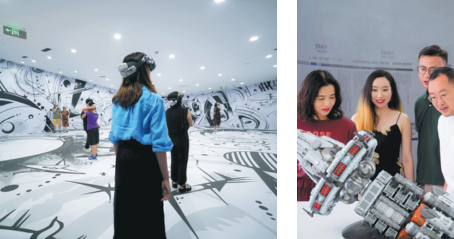Virtual reality facility demonstrates country's sci-fi industry boom

CHENGDU — Strapping on a white head-mounted display at a virtual reality facility in Southwest China's Chengdu, Sichuan province, visitors are instantly immersed into the mind-bending world of The Three-Body Problem, embarking on a journey that spans over three millennia, from China's Zhou Dynasty (c. 11th century-256 BC) to a distant, futuristic realm.
The 25-minute experience culminates in a breathtaking freeze-frame of spaceships orbiting the towering mega structures of the Chengdu Financial City Twin Towers. Guests remove the HMDs and confront the striking reality of standing before the skyscrapers, their imposing 220-meter height a reminder of the stunning fusion of sci-fi imagination and real-world architecture.
This VR facility draws inspiration from Liu Cixin's acclaimed sci-fi Three Body novel series.
The Three-Body Four-Dimensional Space is the world's first offline experience facility recreating the Three-Body Universe, quickly becoming a pilgrimage site for fans from China and abroad since its launch on Sept 22.
According to Three-Body Universe (Shanghai) Cultural Development Co Ltd, the developer of the Three-Body Four-Dimensional Space, over 10,000 people visited the Chengdu VR experience facility during the three-day New Year's Day holiday.
In addition to Chengdu, the VR project was launched in Xi'an in Shaanxi province and Guangzhou in Guangdong province.
Thanks to VR, fans can immerse themselves in the very scenes described in the book, says Du Chengyan, the VR show manager of the facility. "Through this project, we aim to pave the way for Chinese sci-fi to shine internationally."
The Three-Body Problem portrays the story of physicist Ye Wenjie in the 20th century as she makes contact with the Trisolaran civilization, a species inhabiting a three-sun system, sparking centuries-long conflicts between earthlings and aliens.
After winning Best Novel at the Hugo Awards, a prestigious sci-fi award, in 2015, the book gained an international fan base and was translated into over 30 languages.
The first Chinese city to host the Three-Body project, Chengdu is a mecca for Chinese sci-fi fans as it is also the birthplace of Science Fiction World magazine.
On the first floor of the VR hub, themed zones showcase several creative cultural products, along with a bar area offering specialty drinks and a space to unwind. On the second floor, visitors can try the VR experience.
Through VR, guests experience one of the novel's most iconic scenes — the "rehydration" sequence. In this segment, Sophon, a key character from the book, guides visitors in engaging conversations with historical figures.
"It's so much fun," exclaims an eight-year-old boy nicknamed Nuo Nuo. "There are so many cool spaceships, and it feels just like the real thing!"
His mother, Yu, a 40-year-old fan of the novel, believes that grasping the intricate worldview of Three Body through reading can be quite challenging. However, she sees the VR journey as a valuable supplement, helping to deepen the understanding of both the book and the broader world it portrays.
"It's remarkable to visualize the process of 'dehydration' depicted in the book through VR, with King Wen of Zhou frozen right beside me due to the frigid chaotic eras," she says.
Technologically, the VR project incorporates real-time rendering, motion capture, and ultra-high-definition wireless transmission, according to Zhao Jilong, CEO of the Three-Body Universe.
Zhao expresses confidence in the future of the VR project, with plans to enhance the experience by developing more original story-based content and upgrading technologies.
China has experienced significant advancements in science and technology over the past few decades. The rise of sci-fi culture is a natural outcome of this rapid progress, fueling people's imagination for the future.
Sci-fi works like The Three-Body Problem meet people's need to envision the future, Zhao says. "Three-Body IP offers an exciting chance to create a globally resonant cultural phenomenon and symbol here in China."
According to the 2024 China Science Fiction Industry Report, the total revenue of China's sci-fi industry exceeded 100 billion yuan ($13.7 billion) for the first time in 2023, marking year-on-year growth of 29 percent and exceeding 10 times the figure in 2016.
An increasing number of domestic sci-fi novels are finding success both in China and internationally, with film and television adaptations of these works also achieving widespread global acclaim.
The Chengdu municipal government has also rolled out the Chengdu Science Fiction Industry Development Plan (2023-27), outlining seven goals that include expanding the sci-fi industry cluster and building a vibrant sci-fi market.
Leveraging Chengdu's abundant sci-fi resources and strong policy support, Zhao says that the company plans to fully explore the "sci-fi plus "cross-industry model and develop more projects with educational, economic and entertainment value to further promote sci-fi culture.
At the VR facility, guests can also enjoy themed drinks inspired by the novels, such as "Green Tempest "and "Commander's Tea", combining the thrill of shopping with the immersive atmosphere of the Three-Body Universe.
Tang, a 51-year-old sci-fi enthusiast visiting for the second time, says she ordered a drink called "Humanity's Sunset" and carefully framed her shots, searching for the perfect photo to capture the moment.
Xinhua

Today's Top News
- Evidence mounts of Japan's wartime atrocities
- Gunmen kill 11, wound many on Sydney beach
- Study finds Earth's deep water reservoirs
- China remembers victims of Nanjing Massacre 88 years on
- Philippines' provocations will avail it nothing: China Daily editorial
- China steps up financial support to spur consumption






























